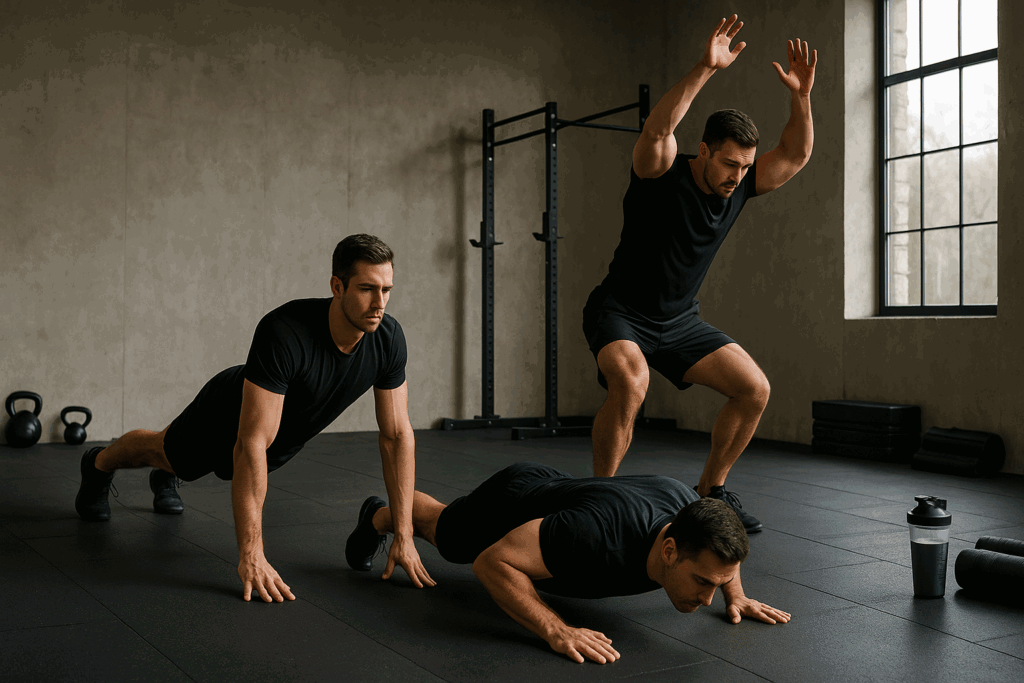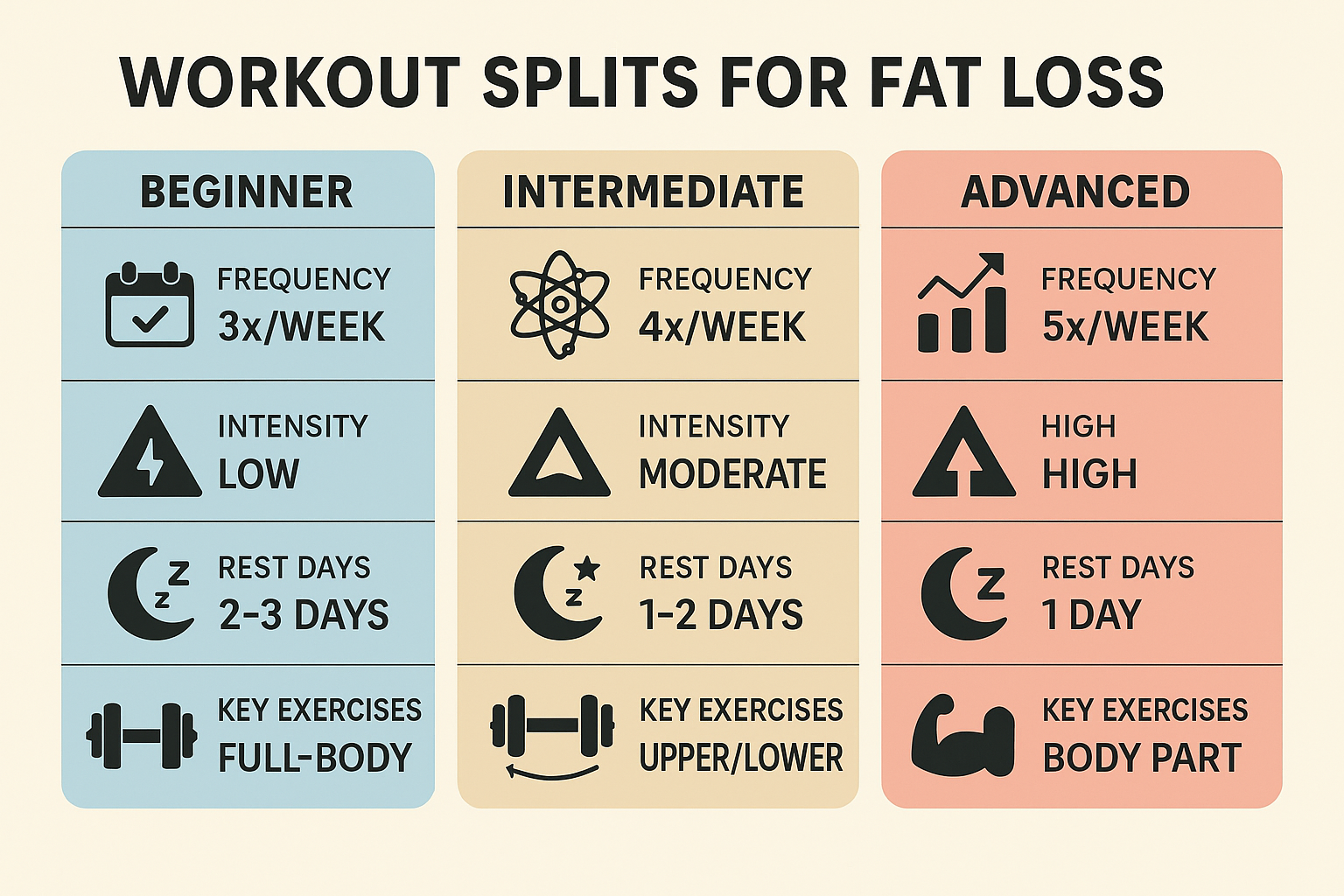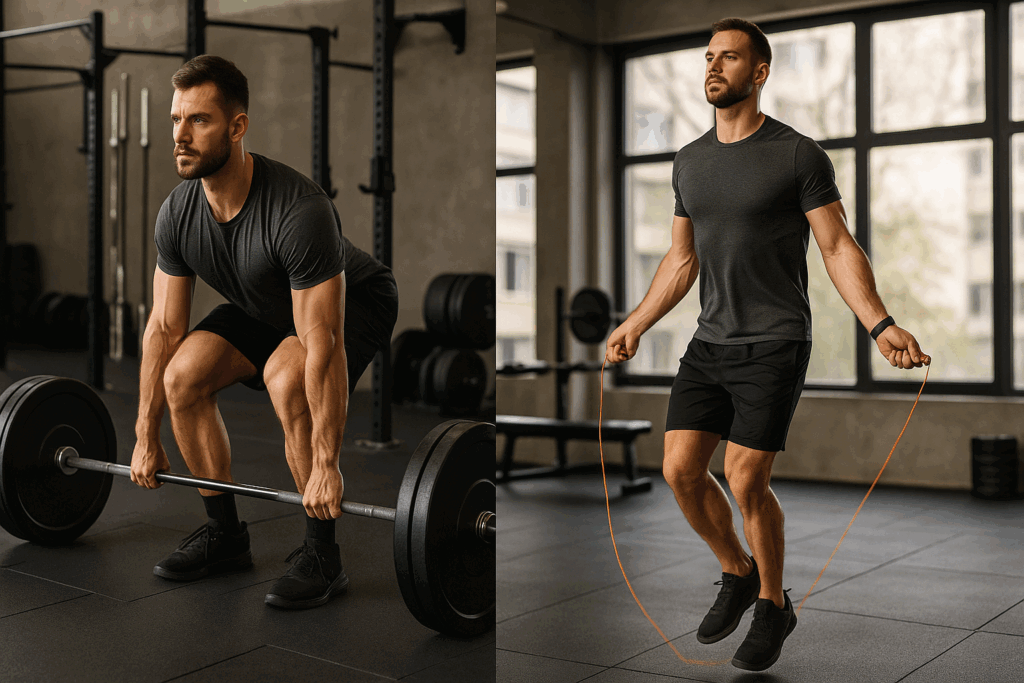Understanding the Science Behind the Best Workout Split for Fat Loss
Crafting the best workout split for fat loss is not merely a matter of tradition or trend—it is grounded in physiology, exercise science, and behavioral psychology. The structure of your training program profoundly influences how your body metabolizes fat, builds muscle, and sustains long-term weight loss. For those serious about optimizing body composition, it is imperative to understand how training frequency, intensity, and exercise selection interact with metabolic demands and hormonal responses.
The term “workout split” refers to how your weekly training sessions are divided by body part, movement pattern, or training goal. The best workout split for fat loss tends to emphasize full-body or upper-lower splits over isolated muscle group routines. This is because engaging larger muscle groups and incorporating compound movements induces a greater metabolic response. Exercises like squats, deadlifts, and presses elevate heart rate, boost post-exercise oxygen consumption (EPOC), and create a hormonal environment conducive to fat oxidation.
Scientific literature supports the use of resistance training as a powerful tool for fat loss. Unlike cardio alone, which primarily burns calories during the activity, weight training elevates resting metabolic rate through muscle preservation and hypertrophy. This means your body continues burning calories long after the session ends. Additionally, optimizing training frequency—typically three to five sessions per week—ensures adequate stimulus without leading to overtraining. For sustainable fat loss, balancing progressive overload with proper recovery becomes the cornerstone of any successful program.
You may also like: The Ultimate 30-Day Workout Plan for Men Working Out in the Gym: Proven Full Body Strength Exercises to Maximize Results
Building the Best Workout Split for Fat Loss Around Resistance Training
Resistance training forms the bedrock of effective fat loss strategies for men. It helps preserve lean muscle mass during a caloric deficit, thereby maintaining basal metabolic rate and supporting sustainable weight reduction. A well-designed training split ensures that muscle groups receive appropriate stimulus and recovery, promoting both fat oxidation and muscular adaptation.
For example, an upper-lower split performed four times per week can provide the perfect balance between volume and recovery. On upper-body days, exercises might include bench press, pull-ups, shoulder presses, and rows, while lower-body sessions focus on deadlifts, lunges, squats, and leg presses. This configuration allows sufficient frequency for each muscle group while keeping the sessions intense and metabolically demanding.
Incorporating progressive overload—systematically increasing the weight, reps, or time under tension—ensures continual progress. Compound lifts, supersets, and circuit training formats are especially effective for maximizing caloric burn in a shorter time frame. Research shows that combining strength and hypertrophy training methods increases both fat oxidation and lean mass retention, making it a core feature in the best fat burning weight lifting workout routines.
Moreover, rest intervals can be manipulated to increase metabolic intensity. Shorter rest periods between compound movements, for example, keep the heart rate elevated, blurring the line between cardio and weight training. This hybrid approach yields powerful results and is frequently incorporated into the best weight training workout for weight loss regimens for men.

Integrating High-Intensity Conditioning into the Best Workout Split for Fat Loss
While resistance training should remain the foundation, integrating high-intensity conditioning is vital for maximizing fat loss efficiency. High-Intensity Interval Training (HIIT) has been extensively studied for its ability to improve cardiovascular fitness while promoting greater fat loss than traditional steady-state cardio. When strategically integrated into your weekly split, HIIT complements strength sessions without causing burnout.
A typical weekly structure might alternate between resistance training and short, high-effort conditioning sessions—such as sprints, battle ropes, or kettlebell circuits—on non-lifting days. These sessions elevate EPOC and enhance insulin sensitivity, both of which contribute to improved fat metabolism. For men pursuing gym workouts for fat loss, adding HIIT two to three times a week can significantly enhance results without detracting from recovery.
One effective format is the hybrid push-pull split that combines metabolic resistance training and HIIT. For example, a pull day could feature barbell rows, chin-ups, and Romanian deadlifts followed by intervals on the rowing machine. These workouts blend anaerobic and aerobic systems, forcing the body to mobilize fat stores more aggressively. Furthermore, HIIT is highly adaptable, making it suitable for home workout for weight loss male routines and gym-based programs alike.
It’s important to balance intensity with volume, ensuring that HIIT sessions do not interfere with resistance performance. This balance is crucial for the longevity of any best weight loss workout for men program. When implemented correctly, conditioning serves as an accelerant to an already powerful fat loss formula.

Why Full-Body Splits Remain the Best Fat Loss Workout for Men
While many traditional bodybuilding programs favor body part splits, full-body workouts have re-emerged as a dominant method in weight loss workouts for men. Full-body training ensures frequent muscle engagement, which in turn leads to higher weekly caloric expenditure and better hormonal responses. Each session becomes a full-system challenge, making it ideal for those looking to improve composition quickly and efficiently.
A full-body split performed three times a week—alternating between strength emphasis and metabolic conditioning—hits all major muscle groups consistently without risking overtraining. This method is particularly beneficial for beginners or those returning after a hiatus. For a fat man workout plan focused on rapid transformation, full-body routines offer maximal return on investment.
From a scientific standpoint, frequent muscle activation boosts protein synthesis and enhances mitochondrial density, both critical for fat oxidation. These workouts also typically involve supersets, tri-sets, or short rest intervals that improve cardiorespiratory fitness. This hybrid model resembles what many term metabolic resistance training, widely regarded as a staple in mens fat loss workout plans.
Moreover, full-body training is more adaptable to at-home workouts for men to lose weight. Minimal equipment setups, using bodyweight exercises or resistance bands, can still deliver a powerful metabolic punch. Exercises like burpees, push-ups, squats, and planks can be configured to mimic gym-level intensity, making it a practical solution for those limited by location or time.

Customizing the Best Workout Split for Fat Loss Based on Training Level
An often-overlooked component in selecting the best workout split for fat loss is individual training level. Beginners, intermediates, and advanced lifters all require different structures, volumes, and recovery strategies. A beginner may find success with three full-body sessions per week, while a more experienced lifter might thrive on a six-day push-pull-legs split with added conditioning.
Beginners should prioritize movement mastery, basic compound lifts, and consistency. Simpler full-body or upper-lower splits reduce cognitive load and allow for skill development without risking overtraining. Meanwhile, intermediate trainees can benefit from more sophisticated programming, such as alternating hypertrophy and strength days within their split. This allows them to refine form while introducing progressive complexity.
Advanced trainees often require periodization to avoid plateaus. Techniques such as wave loading, undulating periodization, or incorporating power days can ensure continued fat loss and performance improvement. Advanced lifters may also manipulate training density—such as EMOM (Every Minute on the Minute) protocols—to maximize caloric expenditure while preserving intensity.
Each level benefits from a tailored nutrition strategy to complement the workout plan. The best weight lifting routine for weight loss is only effective when aligned with a caloric deficit and sufficient protein intake. Thus, pairing progressive programming with customized nutritional support ensures holistic fat loss.

Adapting the Best Workout Split for Fat Loss to a Home Setting
Accessibility is a critical factor for many, and not everyone has consistent access to a commercial gym. Fortunately, the best workout split for fat loss can be effectively adapted for at-home execution without compromising results. Whether due to time constraints, budget, or personal preference, home workouts are a viable and increasingly popular option for male weight loss.
Key to this adaptation is exercise selection and intensity modulation. Bodyweight movements like push-ups, squats, lunges, and planks can be combined with tempo variations, explosive movements, and circuit formats to simulate gym-level training. Resistance bands, dumbbells, and kettlebells further expand programming flexibility. When structured effectively, a home workout for men weight loss program can burn significant calories and promote lean mass retention.
Full-body routines performed four to five times weekly can mirror the intensity of gym sessions. Alternating upper-lower splits can also be implemented using minimal equipment. The inclusion of plyometrics—like jump squats and burpees—boosts cardiovascular load, increasing the overall fat-burning potential of the session.
A major advantage of home training is convenience and consistency. Eliminating commute time and equipment wait lines makes adherence easier. This consistency often translates into better long-term outcomes, reinforcing that a home workout for weight loss male audience can be just as effective as traditional gym routines when executed strategically.

Combining Weight Lifting and Conditioning for a Superior Fat Loss Strategy
Blending resistance training and metabolic conditioning is the gold standard in fat loss programming. It is not a matter of choosing one over the other but strategically integrating both for synergistic benefits. Weight lifting for fat loss men emphasizes muscle preservation, metabolic rate elevation, and hormonal balance, while conditioning focuses on cardiovascular health and energy expenditure.
The weekly layout might include three to four resistance sessions focusing on major lifts with accessory work, interspersed with two to three conditioning workouts. On lifting days, finishers such as sled pushes, jump rope intervals, or kettlebell swings can provide a metabolic spike. Conditioning days may include HIIT, steady-state cardio, or circuit training, depending on recovery status and overall workload.
The best weight loss workout for men often alternates these modalities to maintain engagement and avoid burnout. For example, a Monday lift, Tuesday HIIT, Wednesday rest, Thursday lift, Friday low-intensity cardio, and Saturday lift structure provides variety and ample recovery. This non-linear approach mirrors real-life demands and sustains motivation.
Importantly, conditioning does not have to be high-impact or punishing. Activities like swimming, brisk walking, cycling, or rowing offer joint-friendly alternatives that still contribute to overall fat loss. For those following a weight loss gym plan male structure, this dual-modality approach proves both practical and science-backed.

Implementing Effective Recovery in a Fat Loss-Focused Training Split
Recovery is often overshadowed by training intensity, yet it is equally crucial for success. Without adequate rest and recovery, even the best weight lifting routine for weight loss can become counterproductive. Overtraining leads to fatigue, hormonal dysregulation, and decreased performance—each of which stalls fat loss.
Prioritizing sleep, stress management, and proper nutrition enhances recovery. Sleep quality has a direct impact on leptin and ghrelin—the hormones that regulate hunger and satiety. Poor sleep correlates with increased cravings and reduced metabolic rate. Aim for at least seven to nine hours per night for optimal hormonal balance and muscle repair.
Active recovery strategies also support sustainable fat loss. Foam rolling, yoga, light walking, and stretching facilitate circulation and help clear metabolic waste. Including one to two rest or low-intensity days per week ensures the nervous system remains responsive and the body primed for performance.
Moreover, deload weeks—planned reductions in training volume—should be incorporated every four to six weeks, especially in high-frequency splits. These weeks reduce cumulative fatigue and prepare the body for subsequent training phases. The most successful weight training workout for weight loss programs account for recovery as much as they do intensity.

Monitoring Progress and Adjusting the Best Workout Split for Fat Loss
Tracking progress ensures that your chosen workout split continues to align with your fat loss goals. This involves more than just weighing in. Metrics such as strength levels, energy, sleep quality, body measurements, and even photos offer a multidimensional view of progress. Relying solely on the scale can be misleading, as muscle gain and water retention may mask fat loss.
Training logs help identify trends, such as which lifts are improving or where fatigue is accumulating. This data supports intelligent program adjustments, such as increasing volume, shifting exercise selection, or modifying rest intervals. Nutritional tracking complements this, highlighting intake patterns that may need tweaking to break plateaus.
Subjective measures—like how you feel during workouts or recovery quality—should not be overlooked. These often signal overtraining or under-recovery before objective data does. By combining objective and subjective feedback, trainees can refine their approach continuously.
Ultimately, the best workout split for fat loss is dynamic, not static. It evolves with your progress, preferences, and lifestyle. Adjustments should be data-driven, ensuring that every change moves you closer to your desired outcome.
Frequently Asked Questions
1. What Is the Most Overlooked Element in the Best Workout Split for Fat Loss?
One of the most overlooked components in the best workout split for fat loss is how sleep and circadian rhythm directly affect fat-burning hormones. Inadequate sleep disrupts leptin and ghrelin balance, two key hormones regulating hunger and satiety. When sleep-deprived, individuals tend to crave more calorie-dense, high-sugar foods, which can sabotage even the most meticulously planned workouts. Moreover, cortisol levels tend to rise in response to poor sleep, promoting fat retention—especially in the abdominal area. Ensuring proper sleep hygiene and aligning training with natural energy peaks may significantly improve results from any mens fat loss workout plan.
2. How Do At Home Workouts for Men to Lose Weight Compare with Gym-Based Splits?
At home workouts for men to lose weight can be equally effective as gym-based routines when executed with proper structure and intensity. The key is designing workouts that elevate heart rate and promote muscle engagement using minimal equipment. Incorporating explosive bodyweight movements, like plyometric push-ups and jump squats, enhances fat burn while preserving lean mass. Resistance bands and dumbbells can further mimic the resistance offered by gym machines. The flexibility and convenience of a home workout for weight loss male audience often increases long-term adherence, which is a critical factor in sustainable weight loss.
3. Can a Fat Man Workout Plan Safely Incorporate High-Intensity Training?
Yes, but it requires careful progression and monitoring. A fat man workout plan should begin with low-impact, full-body movements that emphasize joint stability and cardiovascular conditioning. As tolerance increases, the individual can integrate controlled intervals of higher intensity, such as step-ups or kettlebell swings. Weight lifting for fat loss men in this category should prioritize compound lifts with moderate loads to stimulate metabolism without excessive joint stress. The gradual inclusion of higher-intensity work is key to avoiding injury while maximizing the benefits of a best fat burning weight lifting workout structure.
4. How Often Should You Change Your Weight Training Workout for Weight Loss?
Variation in a weight training workout for weight loss is crucial to prevent plateaus, but change should be strategic rather than frequent. A common mistake is overhauling a program before adaptations occur. Instead, modifying key variables such as tempo, rest intervals, and exercise order every 4–6 weeks is typically sufficient to stimulate progress. This concept, known as periodization, helps keep the nervous system engaged and the muscles challenged. Even minor tweaks—like switching from barbell squats to front squats—can refresh a stagnant program within your weight loss gym plan male framework.
5. Why Is Nutrition Periodization Important in the Best Fat Loss Workout for Men?
Nutrition periodization, the strategy of adjusting dietary intake to align with training cycles, enhances both performance and fat loss. During high-volume training weeks, increasing carbohydrate intake supports recovery and performance, whereas in lower-volume periods, reducing carbs can promote deeper fat oxidation. This syncing ensures that your best fat loss workout for men is backed by the appropriate fuel and recovery tools. Furthermore, it allows for psychological breaks and sustainability, which are essential for adherence in long-term workout plans for men to lose weight. Strategic refeeding can also preserve metabolic rate during extended calorie deficits.
6. How Can You Combine the Best Workout Split for Fat Loss with Mental Health Benefits?
Physical activity is a proven modulator of mood, and the best workout split for fat loss can be designed to support mental well-being as well. Scheduling strength training in the morning may help lower cortisol levels throughout the day, promoting better focus and reduced anxiety. Including outdoor cardio or walking sessions introduces natural light exposure, boosting serotonin production. Furthermore, consistent training supports better sleep cycles, which are intrinsically linked to mood regulation. By viewing gym workouts for men to lose weight as a holistic practice rather than purely physical, adherence and emotional well-being are enhanced simultaneously.
7. Is There a Difference Between the Best Weight Loss Workout for Men and Muscle Gain Workouts?
While there is overlap, the best weight loss workout for men prioritizes metabolic conditioning, higher training density, and calorie burn. Muscle gain routines focus more on mechanical tension, longer rest intervals, and progressive overload with heavier weights. Fat loss routines often utilize supersets, circuit formats, and shorter rest to maintain elevated heart rates. Weight lifting for weight loss male routines might feature moderate loads and higher volume, contrasting with the low-rep, high-load schemes used in bulking. Each approach serves a distinct goal, though hybrid programs can target both effectively with careful planning.
8. Can the Best Weight Lifting Routine for Weight Loss Be Minimalist?
Yes, minimalist routines can be extremely effective when built around compound movements and progressive overload. For time-constrained individuals, three to four sessions per week using squats, presses, deadlifts, and rows can provide comprehensive metabolic stimulation. These exercises work multiple muscle groups, elevating calorie expenditure and preserving lean tissue. Paired with strategic conditioning sessions, this approach forms a highly efficient fat-burning model. It’s an ideal solution within a gym or even adapted into home workout for men weight loss plans using adjustable dumbbells and resistance bands.
9. What Role Does NEAT Play in Workouts for Guys to Lose Weight?
Non-Exercise Activity Thermogenesis (NEAT) refers to all calories burned through non-structured activity—like walking, fidgeting, or household chores. Increasing NEAT can amplify the effectiveness of formal workouts for guys to lose weight without additional gym time. For example, choosing stairs over elevators, walking during phone calls, or using a standing desk significantly impacts total daily energy expenditure. NEAT becomes especially important when progress stalls despite adherence to the best weight lifting routine for weight loss. It complements structured training and bridges the gap between sedentary behavior and active living.
10. How Should You Modify the Best Workout Split for Fat Loss During a Travel Period?
Travel often disrupts routines, but with minor adjustments, your best workout split for fat loss can remain effective. Focus on bodyweight exercises like push-ups, squats, and planks, which require no equipment and can be done in hotel rooms or parks. Resistance bands offer portability and versatility for continued strength work. Reducing workout volume while maintaining intensity helps preserve progress without overexertion. Also, leaning on NEAT—like sightseeing on foot or airport walks—keeps energy expenditure elevated during transit-heavy days. Planning ahead ensures that gym access or lack thereof doesn’t derail your entire weight loss workouts for men approach.
Final Thoughts: Sustaining Results with the Best Workout Split for Fat Loss
The journey toward fat loss is as much about sustainability as it is about intensity. The best workout split for fat loss is one that fits seamlessly into your life, accommodates your goals, and evolves with your abilities. Whether executed in a commercial gym or a home setting, the principles remain the same: prioritize resistance training, integrate conditioning, and allow for recovery.
Adopting a balanced, research-backed training structure ensures that fat loss does not come at the expense of muscle or health. Strategic programming, consistency, and a deep understanding of your body’s signals enable long-term transformation. This is why the best fat loss workout for men goes beyond aesthetics—it cultivates strength, energy, and discipline that carry over into every facet of life.
Sustainable fat loss is not about the latest fad or extreme measures. It is about mastering the fundamentals, committing to progressive improvement, and finding joy in the process. As science continues to affirm, combining strength training, high-intensity conditioning, and personalized recovery practices results in the most effective and enduring body composition changes.
Whether you’re following a home workout for men weight loss plan or a gym-based strategy, aligning your routine with the principles outlined in this guide will lead to measurable, lasting success. Stay consistent, stay adaptive, and trust the process—your best physique is closer than you think.
Further Reading:
Weight Loss Workout Plan for Men





